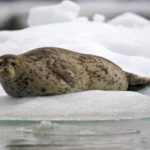25 interesting facts about fur seals
 1Many people find fur seals very cute creatures. They are such, especially since for humans they, unlike some other creatures that look like them, are usually not dangerous. So if you are not confused by the powerful smell of fish, which is inevitable at any rookery of fur seals, on occasion you can take an excursion and look at them closer.
1Many people find fur seals very cute creatures. They are such, especially since for humans they, unlike some other creatures that look like them, are usually not dangerous. So if you are not confused by the powerful smell of fish, which is inevitable at any rookery of fur seals, on occasion you can take an excursion and look at them closer.
As mustaches help ordinary seals to navigate in the dark, so vibrissae also help fur seals to catch any fluctuations in water. Therefore, even in the dark, they are by no means blind.
The smallest fur seals can weigh only about 30 kg, and the largest seals can ten times more. Females are usually noticeably smaller than males, about a third.
At the beginning of the 20th century, some species of these creatures were threatened with extinction, since they were actively hunted because of fur. Fortunately, in 1911, hunting for them was universally banned.
Seals are often the victims of killer whales and sharks.
About 65-70% of the entire world population of these animals lives in the Bering Sea.
In total, there are now about 1.2-1.25 million individuals in the world.
Southern fur seals are inferior in size to their counterparts from the northern hemisphere.
Large and strong male fur seals often acquire a real harem of several dozen females.
These animals easily recognize their relatives by smell and voice, even if they have not seen each other for many years.
In the mating season, they often go in huge flocks, which number hundreds of thousands of individuals. The largest seasonal rookeries of fur seals are in Russia, on the island of Pribylova, in the Bering Sea.
After the first birth, females of fur seals remain in a state of lactation until the end of life.
Females can control the process of their own fertilization. After mating with the male, they can delay the fertilization of the egg for up to several months if the conditions for gestation are currently unfavorable.
Depending on the species, fur seals can live from 12-13 to 25-30 years.
Pregnancy in fur seals can last up to one year.
At birth, only one cub is almost always born.
Despite the fact that fur seals feed mainly on fish and various mollusks, some careless bird may become their prey.
Most of them prefer to live alone, but some get into small groups. In large flocks, fur seals are united only in the mating season.
On land, they are quite clumsy, but in the water, fur seals can reach speeds of up to 20 km / h.
Excellent vision allows them to see prey even at great depths, where there is practically no sunlight.
During the hunt, fur seals can dive to a depth of 150-200 meters.
Usually quite peaceful, in the mating season, they easily become furious. Males sometimes very violently fight each other, competing over the female.
On land and in water, fur seals spend approximately equal time.
In their wool, even the ambassadors of diving under water, there is always air trapped by the wool. Therefore, cold water has virtually no access to their skin, so that fur seals almost never freeze.
From the point of view of zoology, fur seals belong to seals.
The powerful smell coming from the rookery of these animals can be felt at a distance of a couple of kilometers.



























